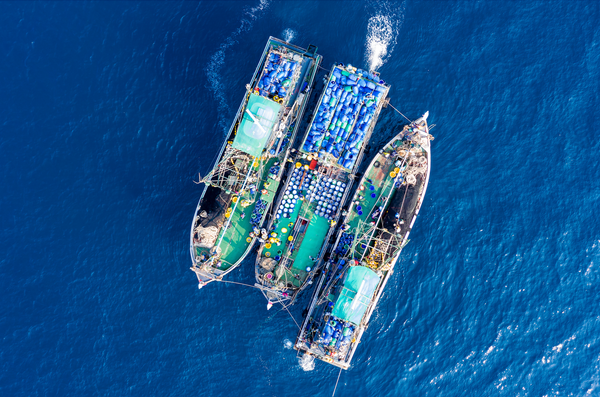Overfishing: Causes, Effects, and Solutions
Updated on May 26, 2021
Despite a seeming overabundance of seafood at restaurants and markets alike, overfishing is a serious issue affecting one-third of sharks, rays, and chimaeras at risk of extinction.
Overfishing doesn’t only affect marine populations – it also has a devastating socio-economic impact. With the right knowledge and tools, fisheries, organizations, and consumers alike can collaboratively reduce overfishing and replenish supplies worldwide.
What is Overfishing
Overfishing refers to the unsustainable practice of capturing or harvesting fish from aquatic environments at a rate that exceeds their natural ability to reproduce and replenish. It occurs when the demand for fish surpasses the capacity of fish populations to recover, leading to the depletion and potential collapse of fish stocks.
What Causes Overfishing?
Overfishing can be caused by a combination of factors, including:
- High Demand and Consumption: As the global demand for seafood increases, fishing efforts intensify to meet the demand, often leading to overfishing and obstacles within the seafood supply chain.
- Advancements in Fishing Technology: While large-scale trawlers, longlines, and fish finders allow fishermen to catch fish more rapidly and in larger quantities, they also contribute to overfishing.
- Lack of Effective Fisheries Management: Inadequate or ineffective fisheries management is a major contributor to overfishing. Poorly designed or implemented fishing regulations, weak enforcement, and insufficient monitoring and surveillance can fail to control fishing activities and protect fish populations.
- Subsidies and Economic Factors: Government subsidies and financial incentives for the fishing industry can encourage excessive fishing efforts. Subsidies often support the construction and operation of fishing vessels, fuel costs, and equipment purchases, leading to overcapacity in the fishing fleet.
- Lack of Data and Scientific Knowledge: Insufficient data on fish populations and their reproductive capacities can make it challenging to assess the health of fish stocks accurately. Inadequate scientific knowledge and understanding of ecosystem dynamics can lead to conservative or inaccurate assessments, potentially allowing overfishing to go unnoticed until it becomes a severe problem.
What are the Effects of Overfishing?
Overfishing has several significant effects on marine ecosystems, fish populations, and human communities. Some of the key effects include:
- Decline in Fish Populations: Overfishing depletes fish populations, leading to declines in their numbers and sizes. Targeted species, such as popular commercial fish like tuna, cod, or salmon, are particularly vulnerable.
- Disruption of Marine Food Chains: Fish play a crucial role in marine food chains, serving as a food source for other species. Overfishing disrupts these food chains, leading to imbalances in ecosystems.
- Loss of Biodiversity: As certain fish populations decline or disappear, it can result in a reduction in species diversity. This loss of biodiversity can disrupt the overall health and functioning of marine ecosystems, making them more vulnerable to other environmental stresses.
- Alteration of Marine Habitats: Some fishing methods, such as bottom trawling, can cause physical damage to marine habitats like coral reefs, seafloor ecosystems, and underwater structures.
- Economic Impact: When fish populations decline, it can lead to decreased catches, reduced revenues, and potential job losses in the fishing sector.
- Food Security and Nutrition: Fish provide a significant source of protein and essential nutrients for many communities around the world, particularly in coastal regions. Depleted fish stocks can lead to higher prices and limited access to fish for local populations.
What is the Solution to Overfishing?
Addressing overfishing requires a combination of strategies and collaborative efforts from governments, fishing industries, scientists, and consumers. Here are some key solutions:
- Sustainable Fisheries Management: Sustainable seafood farm management involves setting and enforcing science-based fishing quotas and catch limits that allow fish populations to replenish and sustainably harvest the fish stocks.
- Ecosystem-Based Approach: Taking an ecosystem-based approach to fisheries management considers the interdependencies of species and their habitats. This approach considers the ecological interactions within marine ecosystems and managing fisheriesto maintain the overall health and functioning of these ecosystems.
- Marine Protected Areas (MPAs): Establishing MPAs helps protect critical habitats, breeding grounds, and vulnerable species. These protected areas provide safe havens for fish to grow, reproduce, and replenish their populations.
- Combat Illegal, Unreported, and Unregulated (IUU) Fishing: IUU fishing undermines efforts to manage fish stocks sustainably. Strengthening monitoring, control, and surveillance measures can help detect and deter illegal fishing activities.
- Promote Selective and Responsible Fishing Practices: Encouraging the use of selective fishing methods and gear can minimize unintended bycatch and reduce the impact on non-target species. Technologies like fishery observers, on-board cameras, and electronic monitoring can help monitor fishing activities and ensure compliance with regulations.
- Support Sustainable Aquaculture: Promoting responsible and sustainable aquaculture practices helps alleviate pressure on wild fish stocks.
- Consumer Awareness and Responsible Choices: Educating consumers about the impact of their seafood choices and promoting sustainable seafood consumption is crucial. Certifications like the Marine Stewardship Council (MSC) and Aquaculture Stewardship Council (ASC) can guide consumers toward sustainably sourced seafood. Learn more about the most sustainable fish to consume in our guide.
- International Cooperation and Collaboration: Collaborative efforts between countries, regional fisheries management organizations, and international bodies are essential for effective fisheries management, data sharing, research, and enforcement of regulations.
Summary
Efforts to enforce smart management systems have since improved the long-term health of hundreds of fisheries worldwide. As the U.S. continues to work endlessly on improving sustainable fishing rights, fishing communities can finally make the comeback they deserve.
However, the responsibility doesn’t just fall on fisheries and large corporations – consumers can combat the overfishing crisis by making more sustainable choices.








